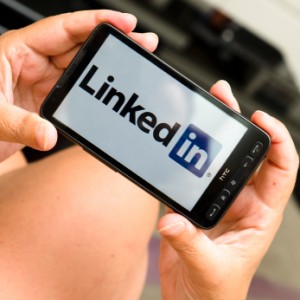Don’t Be a Social Selling Lemming
You probably have a social media presence. You might even call it a social media strategy. But is it really strategic? Or is it just a lemming strategy—making you look like a thousand other firms rushing headlong together toward a cliff? There’s a chance your social selling strategy may not be very strategic at all.
Let’s review a few basics about strategy, then come back to the question.
Competitive Strategy Must Differentiate You
First, a strategy that doesn’t distinguish you from competitors’ strategies is not a strategy at all. The whole point of a competitive strategy is to point out why you, in some important way, are different from your competitors.
This is why the pursuit of “best practices” is not only un-strategic, but it’s anti-strategic. The more you adopt everyone else’s best practices, the more you look like everyone else. A “me-too” strategy isn’t a strategy at all.
Economist Mike Porter suggested years ago there are only two kinds of strategies: being a low-cost producer or being a differentiated producer. Differentiation, in turn, can be along product or industry lines. That makes for three distinctive, differentiable strategies. If you are not following one of the three, then you are in danger of being un-strategic.
What does it mean to be un-strategic? It means you present no compelling reason for anyone to hire you—unless you’re willing to cut your price (an act that often lowers your perceived quality anyway).
The Social Media Lemming Strategy
As the popular myth has it, lemmings throw themselves en masse into the waters in a collective undifferentiated rush toward oblivion. Clearly that’s not a metaphor you want your social media strategy associated with.
But there are two huge forces that drive us all in that direction. One is the zero-marginal cost of volume on the Internet. The other is an obsession with metrics in social media.
Zero-marginal cost: As direct marketers found out to their glee when they discovered Internet marketing, the marginal cost of adding another name to your email list is infinitesimal. The result: spam.
The zero-marginal cost feature has likewise encouraged people to build massive databases, expanded Twitter lists, turned “friend” into a verb, and so on. It all costs nothing. If X is good, then X + whatever must be even better, so why not go for it?
Obsession with metrics: The zero-marginal cost factor is a feature of Internet economics. By contrast, the obsession with metrics is a purely human creation. Encouraged by a tsunami of data supply and a desire to appear scientific on the part of dozens of management gurus, the field of business has been overwhelmed by a tendency to mistake a measurement for the thing that is being measured.
This mistake—basically confusing cause and effect—is evident in the ever-finer increments of activity to be found in CRM systems. It’s embedded in the formulaic insistence of learning and development managers that all training must be evidentially behavioral to be relevant. But nowhere has it become more endemic than in the field of social media.
Think Klout: a metric of metrics. Think Twitter: how many followers you have and how many people you follow. Think LinkedIn: how many “contacts” you have. Think about the incredibly complex mix of analytics put out by Google and a thousand website traffic consultants. All are aimed at improving your metrics. And what do they measure? Basically, more metrics. The ultimate substrate of reality (revenue, anyone?) is sorely missing.
Four Anti-Strategic Social Strategies
- Promoting the Same Content: Consider one social media “strategy,” exemplified by Triberr but also evident in LinkedIn groups. Join a group, and the agreement is “we’ll all promote each other,” thereby driving up everyone’s numbers. Does the metric work? Sure, it works to drive up metrics. The cost, however, is strategic.
If you and 25 others all agree to auto-tweet everyone else’s blog post, you then have 25 people all tweeting the same content. Their twitter behavior becomes asymptotically identical to each other. The result: mass un-differentiation.
- Pumping Up the Numbers: Another social media “strategy” is to simply increase your number of followers. The direct approach is to announce to the world that “I follow.” Thus, any lemming-like-minded twitterer who follows you can automatically expect you to return “the favor,” thereby increasing each of your numbers.
Do the numbers work? Sure. They work to increase your numbers. Eventually, high numbers will get you onto lists—lists like “Top 50 sales bloggers” or similar. Finally, at that point, differences become grossly evident. There really are some true sales experts. And, there are others who got there solely on social media grade inflation. The difference becomes stark. In the sunlight, quality is evident.
- No-Value Content: Another social media “strategy” is a perversion of “content marketing.” Originally (and still, for some people), this meant offering high-quality content in an accessible way to help potential customers develop their thinking. But it rapidly succumbed to the “obsession with metrics” rule.
Today, I get at least one invitation a day from fly-by-night auto-emailing outfits asking if they can write “content” for my site or to embed a link in a post I might make available to them. In any real sense of the word, there is no “content” there.
- The Aggregation Delusion: Mimicking news sites, this delusion consists of writing zero-insight-added blog posts that have titles that begin with “Top 12 reasons why…” They amount to little more than clickbait, since they consist of regurgitated, even directly plagiarized, content from elsewhere. The purpose is to drive clicks and traffic so that the blogger can show up on lists of clicks and traffic. Again, there comes a point in the actual buying process where buyers easily note the difference between vapor-ware and real content.
Don’t Be a Lemming
When you set out to compete on volume alone, you’re up against some seriously tough competition. There is room for only one low-cost producer in any market, and it’s traditionally the one with the highest volume. In an Internet world of zero-marginal cost and a lemming-like belief that more metrics are better, there is no shortage of people willing to bankrupt you by leading the way to bankruptcy. Don’t go there unless you have deeper pockets than anyone else.
Competing on differentiation is inherently more attractive. But a lemming strategy is equally seductive here: just because you can “move the needle” doesn’t mean the needle is connected to anything real. It’s easy to get lost in the supposedly quantitative world of social media metrics and forget that there’s not necessarily any “there” there.
Ask yourself the tough strategic question: Why, really, am I different? And the equally tough follow-up question: How would a customer be able to really notice and appreciate that difference?
If you’re not seriously asking yourself those questions, why should anyone believe your answers? They may click, but they won’t buy.

 Remember all those curmudgeonly quips about how online “friends” were cheapening the real thing? How the Facebook generation was mistaking true friendship for the faux, virtual kind?
Remember all those curmudgeonly quips about how online “friends” were cheapening the real thing? How the Facebook generation was mistaking true friendship for the faux, virtual kind? To anyone who doubts the power of social media, I tell them how I came to know David A. Brock. Dave’s
To anyone who doubts the power of social media, I tell them how I came to know David A. Brock. Dave’s  A colleague recently asked me how I handle LinkedIn invitations from people I don’t really know. Another colleague asked about connecting to people whose reputation is questionable. While the same questions can be asked about Facebook, Google Plus and other social media, because of the differences in the types of services and benefits each offer, I’m only going to discuss LinkedIn here, and address mostly issues relating to trust.
A colleague recently asked me how I handle LinkedIn invitations from people I don’t really know. Another colleague asked about connecting to people whose reputation is questionable. While the same questions can be asked about Facebook, Google Plus and other social media, because of the differences in the types of services and benefits each offer, I’m only going to discuss LinkedIn here, and address mostly issues relating to trust. Superficially, they couldn’t be more different. One is old (and old school), one isn’t. One is in middle market banking, one in social media. Tie, open collar. Midwest, East.
Superficially, they couldn’t be more different. One is old (and old school), one isn’t. One is in middle market banking, one in social media. Tie, open collar. Midwest, East. I’m an enthusiastic user of many social media. I welcome interaction on Twitter (
I’m an enthusiastic user of many social media. I welcome interaction on Twitter ( “Automation is sand in the social gearbox.”
“Automation is sand in the social gearbox.”  You may have noticed a bit of a kerfuffle in the press recently around a company called RapLeaf, and their relationship to personal data on the internet. Briefly, they are one of the few data collectors who identify names.
You may have noticed a bit of a kerfuffle in the press recently around a company called RapLeaf, and their relationship to personal data on the internet. Briefly, they are one of the few data collectors who identify names.  If you’re like me, you enjoyed the recent debate stimulated by Malcolm Gladwell in his New Yorker article titled
If you’re like me, you enjoyed the recent debate stimulated by Malcolm Gladwell in his New Yorker article titled  My guess is about a third of my readers know this subject way better than I do; and the rest have barely heard of it. Hopefully the third will forgive me my errors, in hopes of giving the two-thirds something of interest.
My guess is about a third of my readers know this subject way better than I do; and the rest have barely heard of it. Hopefully the third will forgive me my errors, in hopes of giving the two-thirds something of interest.